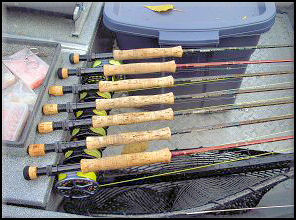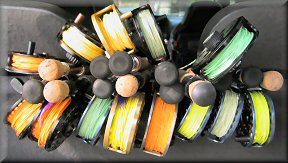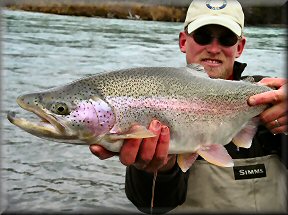
FLY ROD CHOICES:
If I could only pick one rod for the Upper Kenai, it would be a 9-10’ 7wt. A good seven is powerful enough to put the pressure on a big silver or sockeye salmon and light enough to enjoy an 18” rainbow. Longer rods from 9’6” to 10’ are great for managing extended dead drifts and for fishing from the drift boat. I do not recommend rods shorter than 9’.
If you don’t have a seven weight, don’t worry. Rods from 5 to 9 all have a place on the river. On guided trips, I always provide guests with at least one appropriate rod for the fishing conditions.
5wt-Good for light nymphing and possible dry fly action.
6wt- A fast action 6wt is a great all around trout rod. My kenai trout rods are 10' 6wts.
7wt-The best single rod choice.
8wt-Perfect for targeting sockeye and silver salmon. None too heavy for many of our rainbows.
9wt-Great for putting the heat on a fast running sockeye or silver salmon.
For Lower Kenai King Salmon: A powerful 10wt is minimum and an 11 or 12wt is the better choice.
Switch and Spey Rods - Bring them on if you like. We love them. 5-8wt switch or spey rods are great for trout and sockeye. A 9 or 10 will handle Kings. We prefer a solid floating line (not a changeable head) for most trout fishing. The Rio Switch Line is great. Bring a sink tip or Skagit heads for streamers and salmon. The Rio MOW tips in Medium and Heavy are great. Contact Fred with any questions as the options are almost unlimited.

FLY REELS:
Alaska fishing demands premium reels with a quality disc drag. Stacy and I are proud to be members of the Ross Reels USA Pro Staff.
For trout, I love the Evolution 3.5 / Evolution LT 4. Sockeye and silver salmon are perfect on the Momentum 4 /LT 4. For large Kings, a Momentum 5 or 6 / Momentum LT 5 or 6 is the ticket.
FLY LINES:
FLOATING - I recommend a good weight forward floating line as the standard choice for covering most circumstances. At least 80% of our trout fishing is done by “nymphing” with an indicator. If you don’t want to use an indicator for nymphing, a floating line is still a better choice. Swinging a sink tip is likely to result in many foul hooked sockeye salmon when they are thick in the river and spawning. When setting up a rod for nymphing, I recommend overlining by one line size with a nymph style taper. If you are using a fast action rod, you can even overline by 2 line sizes (especially for longer rods). Airflo Ridge Lines are fantastic.
Most anglers targeting sockeye will just keep adding weight to their 9’ leader until they get the desired drift. Casting may not be pretty, but no one complains about the results.
Silver Salmon are usually targeted in slow and slack water areas where a floating line and weighted fly approach works best. A sinking line will likely foul hook fish by dragging the fly over their backs.
SINKING TIP LINES: There are some exceptions, where sinking tip lines may be effective. Sometimes, swinging streamers on mini-tip or sinking-tip lines can provide action early or late in the season. Some anglers prefer using a 300-400 grain sinking tip for sockeye rather than adding heavy weight to their leader.
Fishing for Kings (Lower Kenai only) requires a mini-tip for slow water areas and an extra heavy 400-600 grain sinking-tip line for fast currents.
LEADERS:
Standard 9’ trout or salmon/steelhead-tapered leaders work fine. I usually take an OX or 1X leader and add more tippet. I might go as light as 3X or even 4X with a 5wt and small nymph or dry fly, but 0X and 1X tippets are the norm. Remember that the trout can be large and the currents are strong. There are also incidental sockeye hook-ups. Even with 0X tippet, a large trout or a sockeye may take ten or more minutes to land.
Simple Trout Leader Formula: 24” of 20-pound Maxima Ultragreen mono knotted to 7 feet of 15-pound fluorocarbon with 12-18” of 1X fluorocarbon tippet. An indicator is attached in the middle of the 20-pound section. Split shot are added above the tippet knot. This leader would not turn over a bushy dry fly, but the split shot carries it out. The long belly of fluorocarbon allows the leader to sink quickly with minimal weight. The 20-pound mono is supple enough to allow the fly-line to be mended without moving the indicator.
Sockeye Salmon Leader Formula: This is down and dirty. Take 3 feet of 30-pound Maxima Ultragreen and join it to 6 feet of 20-pound. The split shot goes above the knot. On the drift, a portion of the floating line is pulled down. This creates a belly in the fly-line that pulls the weight along and forces the leader down. The 6 feet of leader swings in a big arc near the bottom and into the path of upstream bound sockeye. Depending on current speed and depth, the leader length may be adjusted. If you feel you are drifting over the fish, just keep shortening the line until you start hooking-up. While a 20-pound leader may seem heavy to most trout anglers for a 6-10 pound fish, sockeye still manage to break off.
Silver Salmon Leaders: Silvers are best fished with a stout tapered leader down to a minimum of 0X or 10-pound.
TIPPET UPDATE: We like Gamma "Frog Hair" leaders and tippet material. The Flourocarbon is excellent as is the regular Frog Hair material. While the listed breaking strength is slightly lower than some brands, the shock factor saves many big fish from the breakoff lunge.
TROUT FLIES (Rainbow Trout and Dolly Varden):
You could probably fish an entire season with two fly patterns and be very successful on the Upper Kenai. With so many options though, I have provided a longer list.
STREAMERS (sizes 2-6)
Double Bunny (gray and white)
Clousers (gray and white)
Zonkers (white, natural gray and purple)
Wooly Buggers (olive, black, brown and mixed)
Strip Leeches (purple, black, brown, light tan or olive)
Wool or Muddler Head Sculpin (olive, black, brown and mixed)
NYMPHS (sizes 10-16)
Hares Ear (olive, tan and black)
Prince Nymph
Caddis Pupa
Most general nymphs that imitate small stoneflies, mayflies and caddis can work at times.
DRY FLIES (10-16)
Elk Hair Caddis
Stimulator
Royal Wulff
Other Attractors
EGG PATTERNS
Glo-bugs tied on #10 and #12 Tiemco 2457 approximately 6-10mm in dimension.
Best colors are Egg, Champagne, Sockeye and Peachy King. Mixing colors is good.
Illiamna Pinky on same hooks. Best chenille color I call peaches and cream.
Glue Gun Eggs
Beads 6-10mm
FLESH FLIES (sizes 4-12)
Ginger Bunny
White Bunny
Peach Bunny
Mixed Fleshy Colors of Bunny Fur
Battle Bunny
Yarn flies with Egg or Champagne colored Glo-bug yarn on #8 Tiemco 2457
Micro Flesh (a little flesh colored yarn, marabou or fur on #12 Tiemco 2457
“Mystic Flies” offers some hot flesh flies you won’t find on any lists.
SOCKEYE SALMON FLIES (size 2-6 Russian River Hook or heavy salmon/steelhead style)
Simple Stealth (black chenille body with a black or blue wing of anything.)
Soft Hackle Stealth (black chenille with a soft hackle color of your choice)
Polar Shrimp
Russian River Coho
Note that just about any small steelhead/salmon fly pattern can work. Shrimpy bonefish patterns are also a good bet. I have seen Sockeye move to take all kinds of flies, but they can be picky. Most often they shy away from big bright colored flies. We take more fish on smaller natural and/or darker flies.
SILVER SALMON FLIES (size 2-6)
Purple Egg Sucking Leech (I like a cone head added for action and weight)
Chartreuse Egg Sucking Leech
Flash Fly (Silver or Purple)
Wooly Buggers with various color combinations and flash added.
Rabbit strip flies with dumbbell eyes in black, purple and pink.
Silvers will take just about anything at times. They can also be very picky. Variety is the key.
KING SALMON FLIES (size 4-2/0)
Green Everglow (Hard to beat, especially in low light)
Comets
Large Bunny Flies / Stip Style Leeches
Intruder Style flies and tubes
Yarn Flies - Limitless possibilities and colors. I usually start with green or chartreuse yarn for wing and or body and add some flash and a tail. Dumbell, bead chain eyes or cone heads can add weight.
WADERS:
I have worn breathable waders since they became available. I will never go back to neoprene. If you can afford them, buy Simm's Waders. They are the best.
For warmth, I wear fleece pants and/or sythetic fiber long underwear (like Patagonia Capilene) underneath.
JACKET:
A good waterproof wading jacket is a must.
It is not worth risking the enjoyment of your trip by bringing an inferior jacket. Patagonia, Orvis, Simms, Cloudveil and Cabela's make quality jackets. Again, a Simm's Gore-Tex jacket is your best piece of equipment.
LAYERING:
When it is not T-shirt weather, I like a thin synthetic shirt followed by a light fleece pull-over. A heavier fleece jacket can be added for really cool days with a wading jacket on top. A beanie or warm hat is good to bring in the fall along with fingerless gloves.
GLASSES and HAT:
They are important tools for seeing and safety. Quality polarized lenses are important if you want to spot fish.

If you have any questions,
just drop me a line.
Guided Trips
Site Map